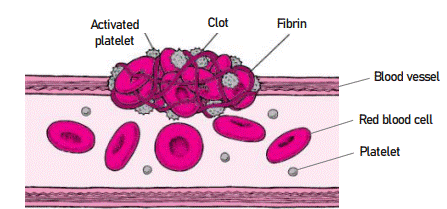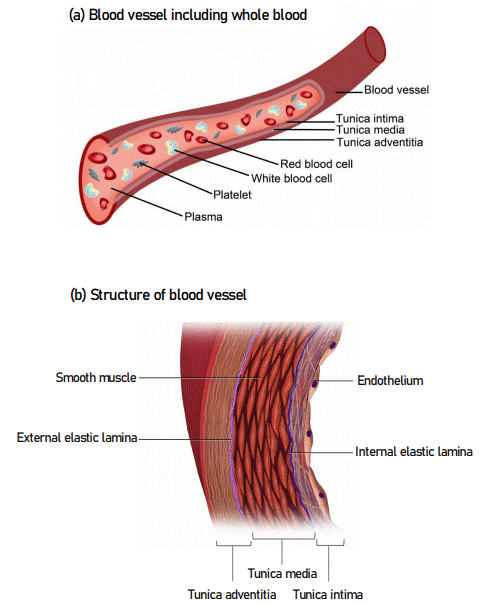Blood clotting, COVID-19, SARS-CoV-2, Symptoms
Coronavirus Disease 2019 (COVID-19) has transmitted almost all over the world after evolving from Wuhan, China in December 2019. The World Health Organization (WHO) declared COVID-19 outbreak a pandemic on March 11, 2020 [1]. COVID-19 is caused by Severe Acute Respiratory Syndrome Coronavirus 2 (SARS-CoV-2) [2,3], which transfers from an infected person to a susceptible person via direct contact (e.g., handshaking, hugging) or indirect contact through touching materials or objects that are contaminated by an infected person (e.g., doorknob, handrail, paper tissue) [4,5]. It can also spread via airborne route (i.e., through aerosols created by expiratory activities) [6,7], which is a real concern. SARS-CoV-2 is a nanosized virus. It varies from 65 to 125 nm [8]. Having such a small size, SARS-CoV-2 could likely be spread in airborne route.
SARS-CoV-2 can enter a susceptible person from an infected person through any of the above transmission methods. Being a respiratory virus, it infects the lungs of human body. Angiotensin-converting enzyme 2 (ACE2) receptor in the host serves as a viral reservoir and SARS-CoV-2 virus binds to this receptor by means of its spike protein (S-protein) [9,10]. After entering the respiratory tract of human body, particularly the lungs, SARS-CoV-2 viruses may cause the most common symptoms of fever, dry cough, and fatigue [11,12]. They may also cause sore throat, headache, chill, runny nose, loss of taste or smell, skin rash, muscle pain, nausea and vomiting, loss of appetite, diarrhoea, dizziness, abdominal pain, and discoloration of fingers or toes [11-13]. The severe symptoms of COVID-19 are shortness of breath or difficulty in breathing, chest pain, and loss of speech or movement [12]. Recently, blood clotting has emerged as a new risk of COVID-19 [14]. Indeed, skin rash and discoloration of fingers or toes are the visible signs of blood clotting [15]. The reduction of oxygen level in blood is another indication of blood clotting [16], as the oxygen supply to the tissues and organs of human body will be greatly affected if blood clots occur.
Blood clotting is the process of making gel-like clump consisting of red blood cells, fibrin, and platelets that plug the injured or cut blood vessel to stop bleeding. The blood clotting process has been simply illustrated in Figure 1. When an injury or a cut occurs in the blood vessel, platelets activate, change form from round to spiny with increased contact area, and release proteins that stick to more platelets and other blood cells; in addition, the blood proteins generate long strands of fibrin, which go around the clumped platelets and blood cells [17]. Fibrin strands help hold the clot in place and plug the injury in the vessel wall. The formation of blood clots is driven and balanced by the body’s control system. After the blood vessel is healed, the clots are also dissolved by the body’s control system. This control system can be impaired in the cases of some diseases. As a result, widespread blood clotting could occur due to minor injuries in the blood vessel.

Figure 1. Process of blood clotting (adapted from [16]).
Many COVID-19 patients died due to severe blood clotting. However, how SARS-CoV-2 causes blood clotting is still unclear. Recently several researchers [18] have hypothesized that SARS-CoV-2 is attached to ACE2 receptor existing in the endothelium of blood vessels through its S-protein; later the bound viruses cause infection and internal injury in the vascular wall of blood vessels; this viral injury could activate coagulation and form surges of internal blood clots. Furthermore, some researchers [19] think that SARS-CoV-2-induced cytokine storm may be another reason of blood clotting in the blood vessels. Coronaviruses can reach different locations of human body including the blood vessels although they first penetrate the lungs. When the endothelial cells in tunica intima are injured by SARS-CoV-2, they send “SOS” to the immune cells, which rush to the damage sites. The immune cells crowd on the damage sites. The activated immune cells secrete small proteins called cytokines, which prevent the pathogens (e.g., bacteria, viruses) from spreading in the body, contributing to blood coagulation (thickening) with increased viscosity. However, excessive cytokines may lead to uncontrollable blood coagulation. In such condition, anti-coagulants (thinners) present in the whole blood are not quite enough to inhibit blood clotting. The following can also be the probable causes of blood clotting driven by SARS-CoV-2.
1. SARS-CoV-2 viruses can increase the viscosity of blood because of their own physical characteristics. The outer surface of SARS-CoV-2 having protein spikes may cause friction with other ingredients of blood (e.g., red cells, white cells, and platelets) and among themselves. They can also cause friction on the surface of the innermost layer (tunica intima) of blood vessels (refer to Figure 2 [20,21]). It means the blood flow in the blood vessels will be hindered due to the increased resistance against flow. Such impaired blood flow may contribute to cause blood clotting.

Figure 2. Blood vessel and its structure (adapted from [16,17]).
2. SARS-CoV-2 viruses may increase the viscosity of blood by increasing the concentration of the bioparticles in blood. The viscosity of whole blood is directly related to the viscosity of its plasma (the higher the viscosity of plasma, the greater will be the viscosity of whole blood) and the concentration (volume fraction) of the bioparticles present in blood (the larger the concentration of the bioparticles, the greater will be the viscosity of whole blood). This means the effective viscosity of whole blood will increase with the increasing volume fraction of the bioparticles existing in blood. It implies that the whole blood shall be thicker when the increased load of viruses increases the volume concentration of the bioparticles in blood. The extremely increased viscosity could lead to blood clotting in human body.
3. SARS-CoV-2 viruses could interlock with each other because of their characteristic outer layer having protein spikes, leading to the formation of virus clusters. This physical process may also involve the blood cells. In addition, the stickiness of the envelope of SARS-CoV-2 due to its S-protein and envelope protein (E-protein) could help forming the clusters of viruses and blood cells. Such clusters may form obstacles in the blood vessels and decrease the flow of whole blood, thus contributing to blood clotting.
4. SARS-CoV-2 viruses may attach to the inner lining (tunica intima) of blood vessels, taking the benefit of their sticky outer layer, thus narrowing the vessel space along the direction of the blood flow (i.e., the cross-sectional area of the blood vessels decreases). It is also possible that SARS-CoV-2 particles assemble in several layers with the foremost layer attaching to the tunica intima of blood vessels. Such array of viruses will also decrease the cross-sectional area of the blood vessel. Consequently, the blood flow will be significantly obstructed. Furthermore, the endothelial cells of tunica intima may not help regulate the pressure for blood flow when they are lined with SARS-CoV-2 viruses. The production of enzymes (e.g., nitric oxide) that help inhibit blood clotting may also be impeded when the endothelial cells are attacked by SARS-CoV-2 viruses. These probable consequences eventually may cause blood clotting in extreme condition.
5. The physical structure of tunica intima (refer to Figure 2 [20,21]) reveals that SARS-CoV-2 viruses could easily be attached to the endothelial cell-to-cell links. These links are very thin compared to the other parts of tunica intima. Hence, the inner lining can easily be ruptured by SARS-CoV-2 viruses at those thin links and the underlying internal elastic membrane can be exposed. This damage may trigger blood clotting inside the blood vessels. The breaching of tunica intima shall result in rushing of additional platelets and clotting factors (e.g., prothrombin, fibrinogen) to the damage sites and they would start the process for the formation of blood clots.
6. SARS-CoV-2 viruses would decrease the velocity of whole blood being in the blood vessel. This is due to the additional mass of viruses or owing to the thickening of blood in the presence of virus particles. Since blood is a non-Newtonian flow, its viscosity increases at a lower velocity [22]. Also, the low flow state of blood enhances the molecular interactions of blood cells among themselves and with plasma proteins. Consequently, blood cells (particularly red cells) can agglomerate to form the clusters of cells, thus increasing further increase the viscosity of blood. At a very high viscosity caused by a high degree of molecular interactions, blood may stop flowing if the driving pressure remains below the yield stress that initiates flow. Moreover, platelets can get closer at a higher viscosity and the cluster of platelets, acting along with plasma proteins, can entrap red cells to form blood clotting.
- Cucinotta D, Vanelli M (2020) WHO declares COVID-19 a pandemic. Acta Biomedica 91: 157-160. [Crossref]
- Pal M, Berhanu G, Desalegn C, Kandi V (2020) Severe Acute Respiratory Syndrome Coronavirus-2 (SARS-CoV-2): An update. Cureus 12: e7423. [Crossref]
- Safiuddin M, Salam MA (2020) Efficiency of surgical masks as a means of source control of SARS-CoV-2 and protection against COVID-19. Int Res J Pub Environ Health 7: 179-189.
- Safiuddin M, Salam MA (2020) Protection efficiency of N95 respirator against COVID-19: An epigrammatic review. Int J Acad Res Ref 8: 26-31.
- World Health Organization (WHO) (2020) Transmission of SARS-CoV-2: Implications for infection prevention precautions.
- Asadi S, Bouvier N, Wexler AS, Ristenpart WD (2020) The coronavirus pandemic and aerosols: Does COVID-19 transmit via expiratory particles? Aerosol Sci Tech 54: 635-638.
- Klompas M, Baker MA, Rhee C (2020) Airborne transmission of SARS-CoV-2: Theoretical considerations and available evidence. JAMA 324: 441-442. [Crossref]
- Shereen MA, Khan S, Kazmi A, Bashir N, Siddique R (2020) COVID-19 infection: Origin, transmission, and characteristics of human coronaviruses. J Adv Res 24: 91-98. [Crossref]
- Jain A (2020) ‘COVID-19 and lung pathology’, Indian J Pathol Microbiol 63: 171-172. [Crossref]
- Hoffmann M, Kleine-Weber H, Schroeder S, Krüger N, Herrler T, et al. (2020) SARS-CoV-2 cell entry depends on ACE2 and TMPRSS2 and is blocked by a clinically proven protease inhibitor. Cell 181: 271-280. [Crossref]
- Centers for Disease Control and Prevention (CDC) (2021) Symptoms of COVID-19.
- World Health Organization (WHO) (2021) Coronavirus disease (COVID-19) pandemic.
- Harvard Medical School (2021) COVID-19 basics. Harvard Health Publishing.
- Pattanayak M (2020) COVID-19: How blood clots are involved – and how they could be deadly (available online).
- Cha AE (2020) ‘Frostbite’ toes and other peculiar rashes may be signs of hidden coronavirus infection, especially in the young. The Washington Post.
- National Blood Clot Alliance: Stop the Clot (2021) How is PE diagnosed? Understanding PE diagnosis.
- Moake JL (2020) How blood clots. Merck Manual: Consumer Version. Merck Sharp and Dohme Corp. Kenilworth, NJ, USA.
- Biswas S, Thakur V, Kaur P, Khan A, Kulshrestha S, et al. (2021) Blood clots in COVID-19 patients: Simplifying the curious mystery. Med Hypotheses 146: 110371. [Crossref]
- Jose RJ, Manuel A (2020) COVID-19 cytokine storm: the interplay between inflammation and coagulation. The Lancet Respir Med 8: e46-e47. [Crossref]
- Wise GEEK (2021) Composition of the blood.
- Wikimedia (2021) The structure of an artery wall.
- Klabunde RE (2017) Cardiovascular physiology concepts.


